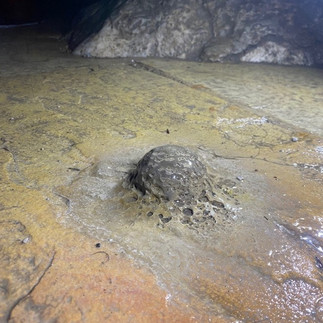Lime kiln waste and the formations of Poached Egg Chamber
- John Gunn
- Sep 9
- 3 min read
Keep an eye on the ground when you are walking through the cave as rocks are growing down there. Stalagmites grow when a drip from the roof hits the floor and deposits a little bit of the mineral calcite, and they quite happily grow on paths and even on railings inside Poole’s. They grow especially fast in the part of the cave we call the “Poached Egg Chamber”. So fast, in fact, that staff recently had to remove some two of them. This isn’t a simple operation – the cave is a protected “Site of Special Scientific Interest”, so permission has to be obtained from Natural England before changes like this are made. But these two were beginning to become a trip hazard so they really did have to go.
Left: One of the stalagmites in situ on the floor at Pooles Cavern. Middle: The two specimens removed and awaiting scientific analysis. Right: the sectioned sample showing the powdery and hard layers formed over the annual cycle
These fast growing stalagmites are curious things when you cut into them. They have a really layered structure, with a hard glassy layer that is always paired with a powdery white layer which commonly has holes in it. We know from previous research efforts (https://doi.org/10.1191/095968399676312548) that each pair of layers formed in just one year. You can see in the picture below that the powdery layers are always thicker, and the pairs are 1-3mm thick. At that rate, the piece in that photograph grew in 20 or 30 years. But wait a moment – didn’t the custodian tell you it took thousands of years to grow a stalagmite? That’s absolutely true, normally, but these ones in Poached Egg Chamber are a bit special.
The Poached Egg stalagmites grow exceptionally fast because in addition to the normal process of rocks dissolving and redepositing below the drip, the waters there are affected by lime waste on the surface that was left behind when limestone rock was burned to make agricultural products. Lime burning on Grin Low ended over 100 years ago but quarrying of limestone is still an important industry in the Buxton area. The lime residue dissolves into the water raising the amount of calcium in it, and also pushing up the pH to make it unusually alkaline. That has been known for decades, but in the last year a Northumbria University research project has shown that the residue doesn’t affect the water in the summer, but it does in the winter. In the graph below you can see a red line for pH, and when this goes up above a value of 8.5 that is when the water is being affected by the residue. These waters have quite low electrical conductivity, which means there is actually less dissolved in them than the “normal” water in the cave stream.. However, high pH leads to fast growth of stalagmites, makes powdery layers with holes in them and makes trip hazards grow on our paths.

Cave water monitoring data showing pH (red) and conductivity (blue) throughout 2025 so far. pH is higher during the winter months causing the powdery layers to form.
Those trip hazards contribute to the story, because the two little stalagmites that were removed will have a record of the way the industrial residue locked in them was deposited. So will the longer stalagmite that was removed in 1997 for the original study that showed the layers were each one year long. And together, those stalagmites hold a memory of how the residue has affected the water since the 1920’s. We now have them in our friends labs at the University of Hull, where we will extract the long story of how the impact of the old lime burners on Grin Low has been slowly, slowly washing away.
So have a look down as you walk through the cave, especially near Poached Egg Chamber. Let us know if you see any other trip hazards which remember the long tale of our national recovery from our industrial age and perhaps we will be able to explore their story too.









Comments